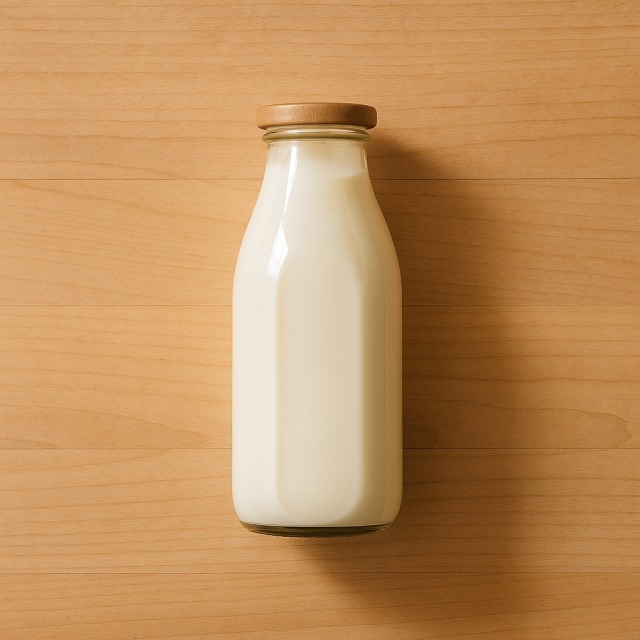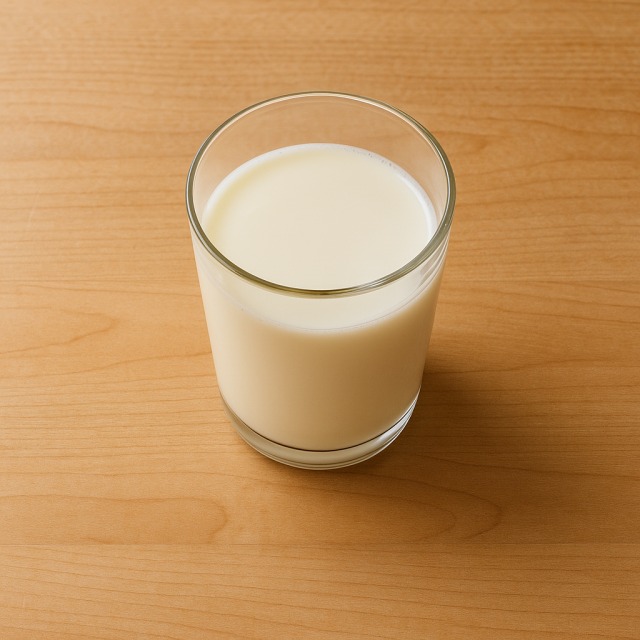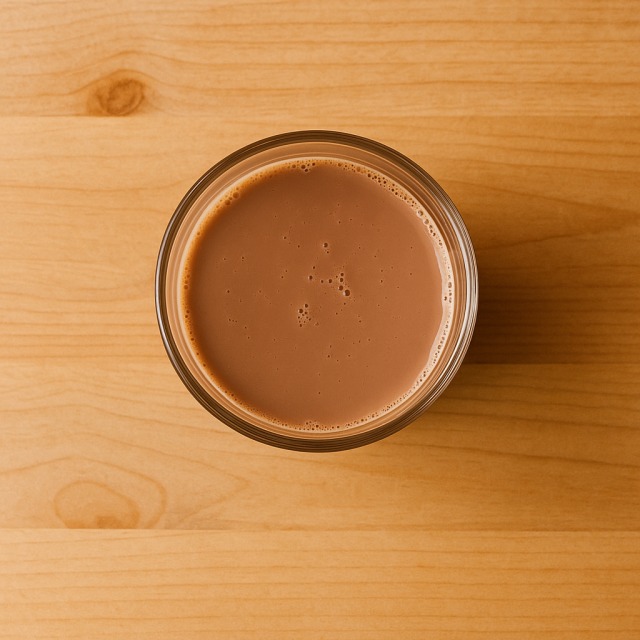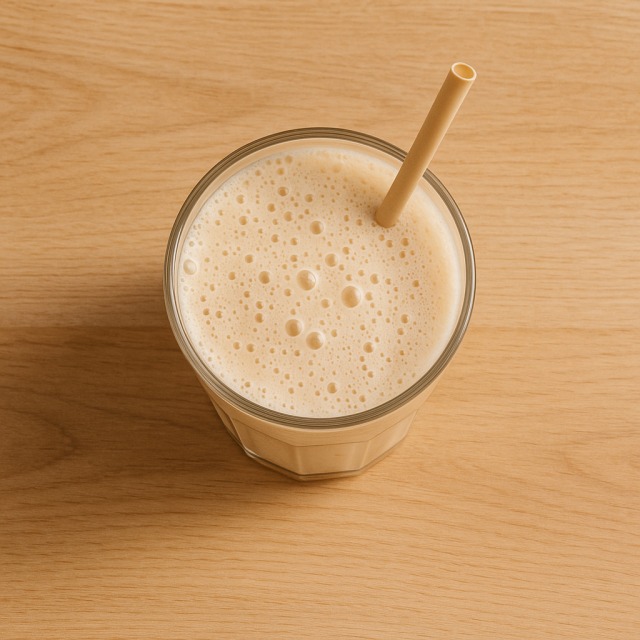Calorie Chart / Beverages / Milk - Semi-skimmed
How Many Calories Are in Semi-skimmed milk?
Calculation of the nutritional value & Recommended Dietary Intake of semi-skimmed milk
For ml and a calorie requirement of kcal
| Calories 115 kcal | Proteins 8 g | Lipids 4 g | Carbohydrates 12 g |
| 6% | 11% | 6% | 4% |
Health benefits of semi-skimmed milk
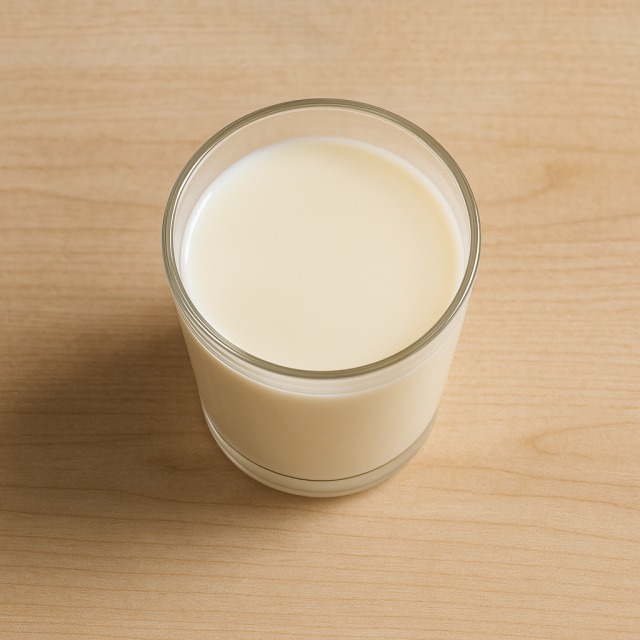
Semi-skimmed milk - 100ml
Calories 46 kcal
Proteins 3.2 g
Lipids 1.6 g
Carbohydrates 4.6 g
Semi-skimmed milk is considered a moderate-calorie food, providing a useful compromise between the richer taste of whole milk and the lighter profile of skimmed milk. Thanks to its 3.2 g of protein per 100 g, it supports muscle maintenance while keeping calories under control. It is naturally rich in calcium and phosphorus, two minerals essential for bone mineralisation, and supplies vitamin B2 (riboflavin) and vitamin B12, both involved in energy metabolism—again helping the body manage calories efficiently. Iodine, potassium, and small amounts of vitamin D complete its micronutrient profile.
The moderate calories of semi-skimmed milk make it suitable for weight-management programmes, yet its fat content (1.6 g/100 g) is enough to carry fat-soluble vitamins and improve flavour. Studies also suggest that the conjugated linoleic acid naturally present in cow's milk could contribute to body-fat regulation, although evidence remains limited. Historically, semi-skimmed milk became popular in Europe after World War II, when skimming technology allowed dairies to standardise fat levels and, indirectly, calories. Pasteurisation plus homogenisation ensures microbiological safety without dramatically altering calories or nutrients.
In short, semi-skimmed milk offers protein, minerals, and vitamins at a moderate calorie cost; people watching their calorie intake can therefore integrate it daily without the excess calories often linked to richer dairy products.
Tips for incorporating semi-skimmed milk into a balanced diet
Because its calories are moderate, semi-skimmed milk lends itself to balanced breakfasts: pour 150 ml over oat flakes, add slices of apple, and a sprinkle of chia seeds. You will obtain fibre, omega-3, and extra protein while keeping calories reasonable. If you prefer a warm option, blend the milk with a ripe banana and a spoon of peanut butter for a quick smoothie; the naturally sweet fruit limits the need for added sugar and therefore extra calories.
At lunch or dinner, use semi-skimmed milk to prepare a lighter Béchamel sauce for a vegetable gratin of broccoli or cauliflower. Swapping whole milk for semi-skimmed reduces calories per serving without sacrificing creaminess. Another idea is incorporating it into pancake batter: compared with whole-milk batter, you save several calories per crêpe, leaving room for fresh fruit toppings rather than sugary spreads.
Sport-minded readers can mix semi-skimmed milk with a scoop of whey powder after training; the drink delivers extra protein while avoiding the surge in calories that comes with full-fat dairy. Finally, for dessert cravings, try a homemade rice pudding combining semi-skimmed milk, a touch of rice, and vanilla: it feels indulgent but remains moderate in calories when portioned correctly.
Frequently Asked Questions
- How many calories are in semi-skimmed milk?
- Semi-skimmed milk provides 46 kcal per 100 g.
- Is semi-skimmed milk low in calories compared with whole milk?
- Yes. Whole milk averages around 64 kcal per 100 g, so choosing semi-skimmed milk cuts roughly 25–30% of the calories while still supplying calcium and protein.
- Does heating semi-skimmed milk change its calories?
- No. Boiling or microwaving does not create or destroy calories; however, water may evaporate slightly, concentrating nutrients and calories per gram, but the absolute calorie content remains the same.
- Can semi-skimmed milk help reduce the calories in sauces?
- Absolutely. Replacing whole milk or cream with semi-skimmed milk in béchamel, custard, or mushroom cream lowers the final calories of the dish without drastically altering texture.
- Is semi-skimmed milk suitable for a high-protein, controlled-calorie diet?
- Yes. With 3.2 g of protein for only 46 kcal per 100 g, it offers a favourable protein-to-calorie ratio, making it valuable for athletes or anyone counting calories.
- How many calories are in a typical glass of semi-skimmed milk?
- A 200 ml glass weighs about 206 g and therefore delivers roughly 95 kcal (46 kcal × 2.06).
Similar foods
Information provided by Calorie Menu may contain inaccuracies or errors. It cannot, under any circumstances, substitute medical advice or medication.
